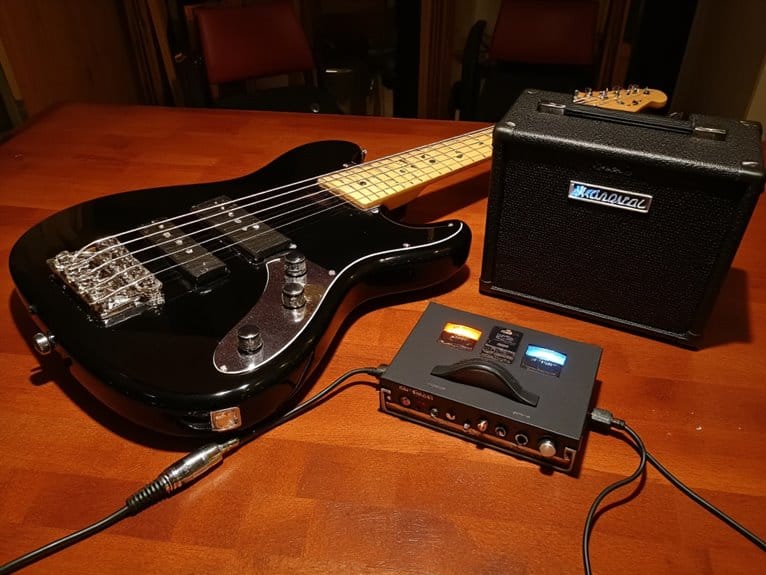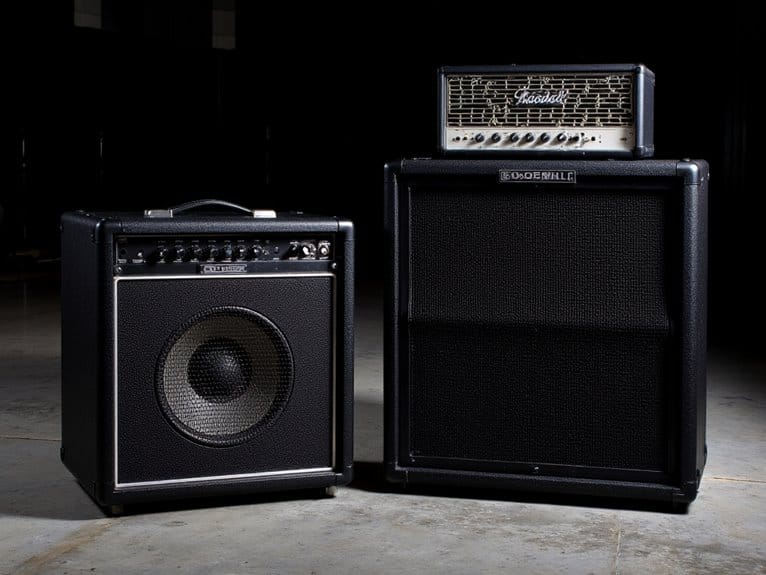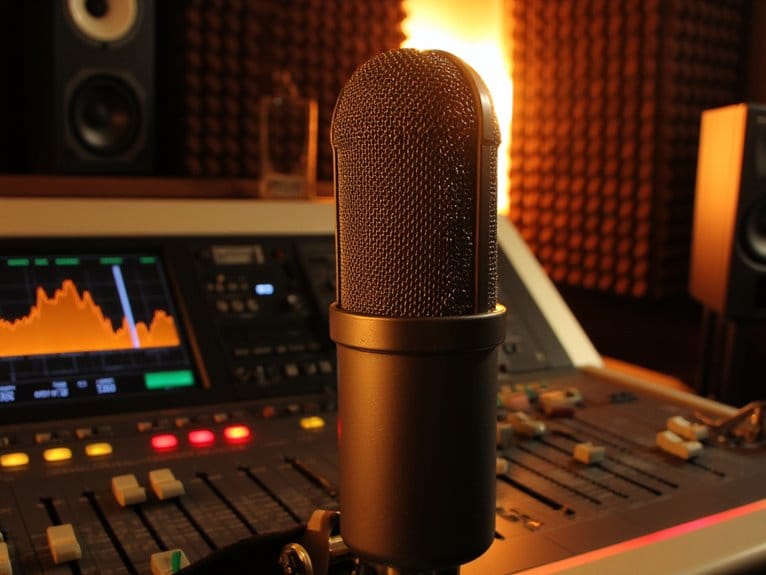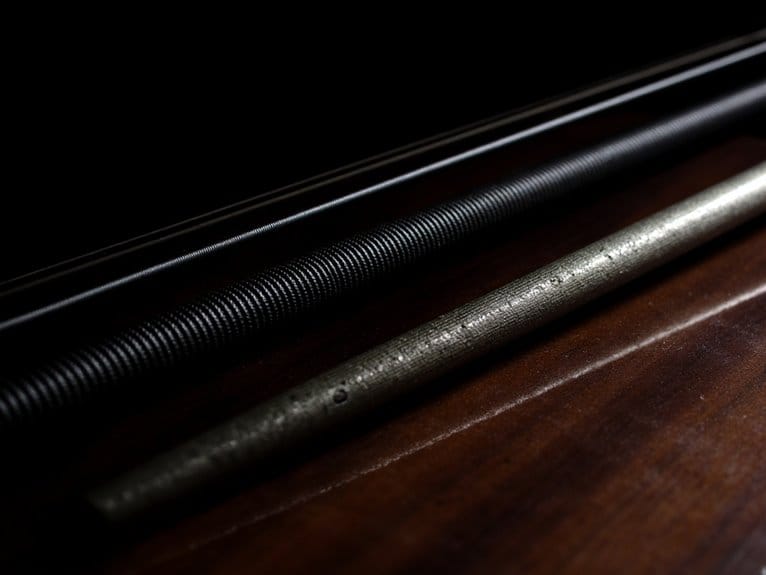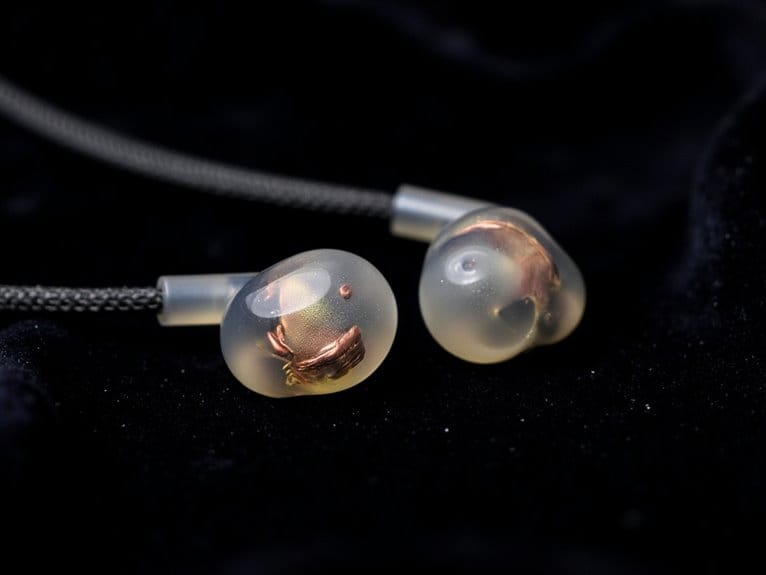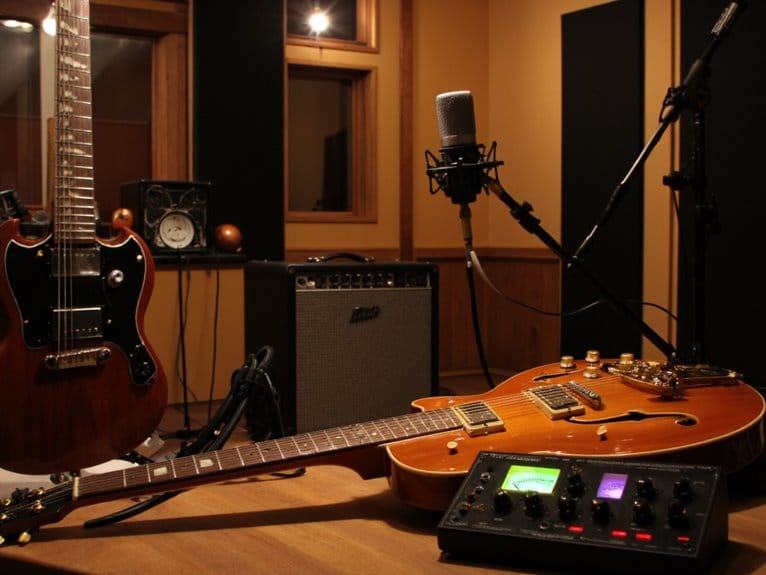Direct Recording vs. Amp Recording for Bass
When you’re recording bass, direct injection captures your instrument’s pure signal with extended sub-bass response down to 12Hz, while amplifier recording adds natural compression, harmonic saturation, and character through tube warmth and speaker coloration. DI offers noise-free recording with extensive re-amping possibilities, making it ideal for pop and electronic genres, whereas amp recording provides that tactile feedback and room-filling presence that rock and blues demand. Understanding these fundamental differences will help you choose the method that best serves your musical vision.
We are supported by our audience. When you purchase through links on our site, we may earn an affiliate commission, at no extra cost for you. Learn more.
Notable Insights
- Direct injection (DI) captures clean, uncolored bass signal while amp recording adds natural compression and harmonic coloration.
- DI recording requires minimal equipment and eliminates room noise, making it ideal for untreated spaces and budget setups.
- Amp recording provides character-rich sound with tube saturation and speaker coloration but needs more complex equipment setup.
- Genre preference varies: pop and electronic music favor DI clarity while rock and blues benefit from amp warmth.
- DI offers extensive post-production flexibility including re-amping capabilities, while amp recording captures immediate performance dynamics and feedback.
Understanding Direct Injection and Amplifier Recording Methods
When you’re deciding between direct injection and amplifier recording for bass, I’ve found that understanding the fundamental differences between these two approaches can dramatically impact your final sound, workflow, and mixing options.
Direct injection captures your bass’s pure, uncolored signal by converting the high-impedance output into a low-impedance balanced signal that your audio interface can handle cleanly. The DI advantages include noise-free recording, complete flexibility for post-processing, and the ability to re-amp later.
Amplifier recording, however, captures the natural compression, dynamic response, and amp coloration that comes from your specific amp and speaker combination, giving you that authentic, room-filling sound that many producers crave for character-rich bass tracks.
Tonal Characteristics and Sound Quality Differences
The sonic fingerprint you’ll capture depends entirely on which recording method you choose, and I’ve spent countless hours comparing these approaches to understand how they shape your bass’s fundamental character.
Direct injection delivers exceptional tonal clarity with extended sub-bass response down to 12Hz, while amp recordings add harmonic content through natural tube saturation and speaker coloration.
You’ll notice DI maintains consistent dynamic range without compression, whereas amplifiers naturally compress aggressive playing dynamics, creating expressive response to your touch.
Recording flexibility favors DI since you can re-amp later or apply virtual processors, while amp tracks commit to their captured character.
For noise reduction, DI eliminates room interference and amplifier hum that can plague microphone recordings. Professional studios commonly record concurrent DI versions alongside amped signals to maximize tonal shaping possibilities during the mixing stage.
Microphone recordings excel at capturing the enhanced body that amplifiers provide, particularly in the high-end frequencies where sustained response creates richer harmonic content.
Consider that tube amplifiers produce the warm harmonic distortion that many bassists favor, though they require more maintenance than solid-state alternatives. Additionally, the rich tonal qualities of tube amplifiers can greatly enhance the overall sound of bass instruments, making them a popular choice for genres that prioritize warmth and depth. For players looking to optimize their bass amp performance solutions, combining a tube amp with the right pedals and effects can yield even more dynamic results. Ultimately, the choice between tube and solid-state amps often comes down to personal preference and the specific sound one wishes to achieve.
Many bassists find that 30W output provides sufficient headroom for studio recording while maintaining the natural compression characteristics that define their signature sound. This allows them to achieve a balanced mix without overpowering other instruments. Additionally, pairing these amplifiers with the short scale electric bass can further enhance their tonal range and playability, ensuring a rich and full sound. Musicians often appreciate how this combination allows for expressive performances, particularly in a studio environment where subtle nuances matter.
Equipment Requirements and Technical Considerations
Since I’ve built dozens of recording setups over the years, I can tell you that your equipment choices will greatly impact both your workflow and your final sound quality.
Your equipment choices will significantly impact both your recording workflow and the quality of your final sound.
For direct recording, you’ll need minimal gear: a quality DI box like the Avalon U5, your bass, cables, and an audio interface. The DI benefits include simplified setup, zero ambient noise concerns, and clean signals perfect for post-processing flexibility.
Amp recording demands considerably more equipment: amplifier, cabinet with 12″ or 15″ speakers, dynamic or condenser microphones, XLR cables, mic stands, and proper room acoustics.
While amp characteristics provide natural warmth and dynamic response, you’ll face potential phase issues when combining miked and DI signals, plus careful gain staging becomes critical for ideal results.
Choosing the Right Recording Approach for Your Music
How do you determine which recording approach will best serve your musical vision and practical constraints? Your genre fundamentally drives this decision, as modern pop and electronic styles benefit from DI’s precise tone sculpting capabilities, while rock and blues thrive on amp recording‘s organic warmth and harmonic complexity.
Consider your environment’s limitations-late-night bedroom sessions favor quiet DI recording, whereas well-treated studios enable both creative techniques simultaneously.
- Genre alignment: Pop/electronic styles suit DI precision, while rock/blues benefit from amp character
- Performance dynamics: Amp feedback enhances player expressiveness and tactile interaction during tracking
- Post-production flexibility: DI recordings allow extensive re-amping and tone shaping during mixing
- Environmental constraints: Room acoustics and noise limitations often dictate practical recording choices
- Budget considerations: DI recording reduces setup time and acoustic treatment requirements considerably
On a final note
You’ll find that both direct injection and amplifier recording offer distinct advantages depending on your musical goals, with DI providing clean, versatile signals perfect for modern production techniques, while amp recording delivers the organic warmth and character that many bassists crave. I’ve learned that the best approach often involves recording both simultaneously, giving you maximum flexibility during mixing to blend or choose the sound that serves your song best.

